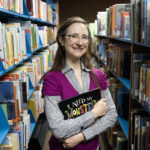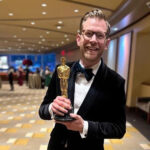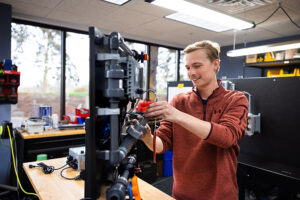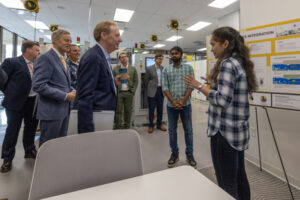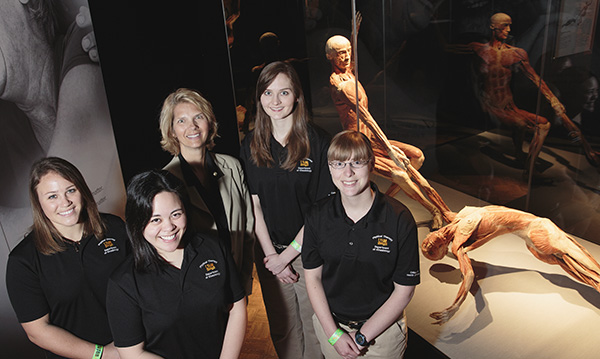
UWM students – along with an instructor – are helping to explain the inner workings of a heart, a knee and a liver.
Students from the College of Health Science’s Doctor of Physical Therapy (DPT) program and Clinical Associate Professor Carlynn Alt are volunteers at the Milwaukee Public Museum’s “Body Worlds & The Cycle of Life” exhibit, which runs through June 15.
It’s not that the exhibit has a shortage of ways to see the wonders of the human body; visitors should plan at least an hour at the exhibit. The UWM representatives – among hundreds of community volunteers who assist at the museum each year – work at a mobile cart that contains the specimens, along with thin cross-sections of a mid-thorax and its organs.
“This is a great opportunity to talk with people who have knowledge about the human body, as well as with those who don’t have much knowledge. It’s also an example of the community service and volunteerism which are a very important part of the profession of physical therapy and part of the UWM experience,” Alt said.
According to Alt, many visitors at the Body Worlds cart are particularly eager to see the human knee, which shows degeneration of the cartilage and offers an opportunity to point out the anterior cruciate ligament (ACL), a ligament commonly injured in the knee joint. “We all have knee problems or know someone who has them,” she said, adding that physical activity and weight management can help maintain knee health.
The DPT is a clinical doctorate in physical therapy, a three-year professional program in the College of Health Sciences. Students enter as a cohort (there are 24 now) and spend their third year in clinical internships.
“From the very beginning, community experience is part of the program. There are many opportunities for students to engage in outreach,” Alt said. In their second week of class, for example, students were working at the Alexian Village retirement community. Alt and students recently completed a seven-week course in exercise and wellness for cancer survivors at Elite Sports Club–North Shore in Glendale.
This is the second time DPT students have worked at a “Body Worlds” exhibit – the first was in 2008, just a year after the program was implemented.
“Body Worlds & The Cycle of Life,” the latest exhibition from physician and anatomist Gunther von Hagens, features the body “throughout the human life cycle and across the arc of aging.” More than 200 plastinates – human specimens preserved through von Hagens’ invention, “plastination” – show the human body across youth, growth, maturity and advanced age, and from health to distress and disease.
Allison Beardsley is one of four DPT students at the UWM cart, where she shared her time with fellow second-year student Sarah Hardcastle.
“Some people approach us and say, ‘Just tell me what you know.’ Others ask a lot of questions,” said Beardsley, who is from Palo Alto, Calif. Part of the students’ preparation was speaking with a heart surgeon about the surgical aspects of the heart on display.
In all, the Milwaukee Public Museum has 83 volunteers and two interns working at “Body Worlds,” including 30 students from the Medical College of Wisconsin. Like all museum volunteers, the students underwent training in museum policies as well as those of the exhibitor. The museum has more than 300 volunteers in all.
Having so many students necessitated evening training sessions, said Marge Schell, MPM’s volunteer coordinator.
“‘Body Worlds’ has strict guidelines,” Schell said. “Everything in the exhibit must be treated with respect at all times. We also went over how to work with the public, and answer questions from people of different ages with different levels of knowledge.”

